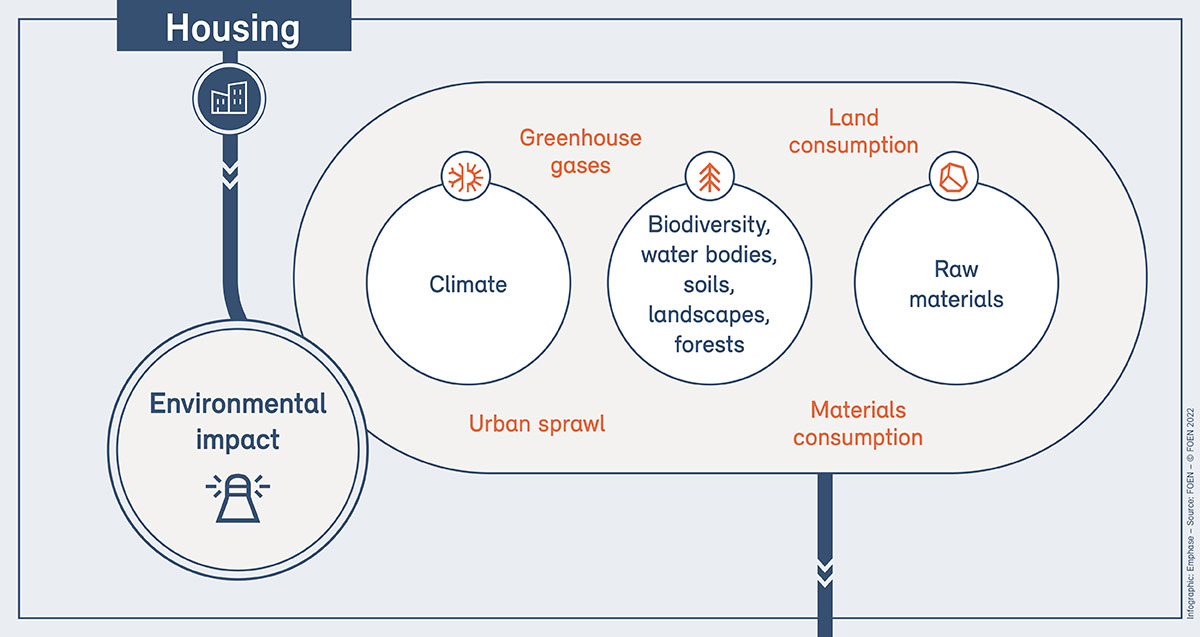Housing is a basic human need. At the same time, it takes up land, requires materials and energy, and causes greenhouse gases.

Biodiversity, soils, landscapes
Settlement areas put enormous pressure on biodiversity, but also offer substitute habitats such as those found on ruderal sites or in wildlife gardens.
Settlements are expanding steadily and now account for 8% of land area. Of these settlement areas, residential areas make up the largest share at around 35%, followed by traffic areas at 30%. Overall, Switzerland's settlement areas grew by nearly a third between 1985 and 2018 (+776km2), although the rate of expansion has slowed down slightly in the last three decades.
Residential areas saw particular growth, increasing by as much as 61% and therefore twice as fast as the population.
Land continues to be lost through development, largely at the expense of cultivated land and ecologically valuable habitats, such as natural meadows and orchards, and landscape quality is decreasing.
Meanwhile, urban sprawl and soil sealing are increasing. The latter has recently gathered pace again (in 2009–2018 compared with 1997–2009). Almost two thirds of settlement and urban areas are now sealed, which means that the soils are covered with non-porous materials.
This urban development is being partly driven by increasing dwelling size demands and the rise in the number of households. The number of single-person and two-person households has increased particularly sharply – due to population ageing and the individualisation of society. This growth in the number of small household, and the fact that older people are remaining in their own homes for longer, even where these are too big for their needs, are key drivers of the increase in living space, which has been rising for some years. The ownership structure, settlement type, building category and year of construction also significantly influence per capita land use. For example, per capita land use is lower in inner cities than in agglomeration belts, and it is much higher among home owners than among those who live in cooperative housing. Moreover, it increases the newer the building.
Nevertheless, in residential areas, there are statistical signs of more economical use of land resources, with the number of single- and two-family houses – which are particularly wasteful in terms of land use – growing more slowly in recent decades, and the number of multi-family houses growing more quickly. In addition, green spaces in settlement areas have generally decreased
Climate
The buildings sector is responsible for a good fourth of the greenhouse gases that are emitted in Switzerland. Between 2000 and 2020, greenhouse gas emissions in the buildings sector fell by 39%. However, the target set out under the applicable CO2 legislation of a 40% reduction versus 1990 was missed.
Currently, the consumption of fuels and electricity over the whole year causes just under two thirds of the greenhouse gas emissions of Switzerland's building stock. This is mainly due to the fact that the majority of occupied buildings use fossil fuels for heating. In particular, Switzerland’s many pre-1980 buildings no longer meet the applicable energy efficiency requirements and standards.
A smaller living space per capita also has a positive impact on energy consumption, as heat consumption rises on an almost linear basis with increasing living space per capita.
Building materials cause some 10% of Switzerland's greenhouse gas footprint. The manufacture of conventional Portland cement in particular is associated with high CO2 emissions, and building materials contain a high level of grey energy from production, processing, transport, construction, demolition and disposal.
These 'grey emissions' always carry less weight in new builds as new buildings are generally more energy efficient thanks to various measures .
Raw materials
It is not only the running of buildings that has an impact on the environment, construction does too.
Around 60 to 70 mio t of a wide range of materials (mainly concrete, followed by gravel and sand) are used annually in Swiss construction projects (building and civil engineering). Construction activity generates the largest share of waste produced in Switzerland (80 %), which consists of 54 mio t of excavated materials and 18 mio t of deconstruction materials. Although the vast majority can be recycled, approximately 18 million tonnes of construction waste take up the limited available space in landfills every year.
In Switzerland, the construction sector predominantly uses energy-intensive building materials, such as concrete, bricks and steel, but rarely timber. However, timber would be beneficial for the environment as it stores a large amount of carbon, and it requires a lot less CO2 to manufacture than other materials.
Further information
Links
Documents
Wohnen mit geringer Umweltwirkung (PDF, 1 MB, 29.06.2020)Im Auftrag des BAFU
Last modification 16.12.2022





